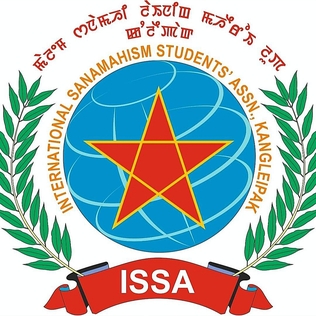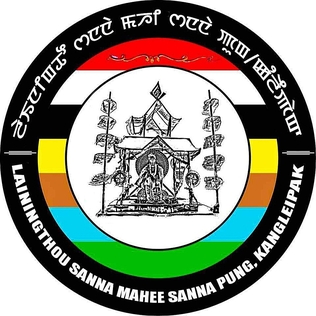
The Meitei script, also known as the Meetei script, is an abugida used for the Meitei language, the official language of Manipur state and one of the 22 official languages of India. It is one of the official scripts of the Indian Republic. It is also popularly known as the Kanglei script and the Kok Sam Lai script. Its earliest known evidence of existence dates back to the 6th century AD coins, engraving the Meitei letters, as verified by the various publications of the National Sahitya Akademi. It was used until the 18th century, when it was replaced by the Bengali alphabet. A few manuscripts survive. In the 20th century, the script has experienced a resurgence, and is again being used. Starting from 2021, Meitei script was officially used by the Government of Manipur, along with the Bengali-Assamese script, to write the Meitei language, as per "The Manipur Official Language (Amendment) Act, 2021".

Sanamahism or Meiteism or Lainingthouism, is an ethnic religion of the Meitei people of Manipur, Northeast India. It is a polytheistic religion and is named after God Lainingthou Sanamahi, one of the most important deities of the Meitei faith. Sanamahi is the eldest son of the supreme god Yaibirel Sidaba and the supreme goddess Leimarel Sidabi. Traditionally every Meitei household, irrespective of the religion, worships Sanamahi and Leimarel Sidabi. The importance of Sanamahi in the religion is also emphasized in the name itself which means Liquid Gold. Sanamahism does not have a religious head but has a body, Maru Loishang that oversees the main religious activities and govern all affairs pertaining to the religion including conducts of priest and priestess. The Maru Loishang also acts a court for religious disputes. There are three main departments under the Pandit Loishang, namely, the Amaiba Loishang, the Pena Asheiba Loishang and the Amaibi Loishang. These departments have existed since the reign of King Meidingu Hongnemyoi Khunjao Naothingkhong of Manipur in 662 AD.

The history of Manipur is reflected by archaeological research, mythology and written history.

Meitei literature, also known as Manipuri literature, is literature written in the Meitei language of Manipur. An ancient institution of learning, the Luwang Nonghumsang, later known as the Pandit Loishang, collected sources of indigenous Meitei knowledge and philosophy until the 18th century. Writing by Meiteis is assumed to go back to the Kingdom of Kangleipak in the early 12th century. The Meitei script is a Brahmic abugida. It is known only from the Puya manuscripts discovered in the first half of the 20th century. Manuscripts of the 18th and 19th centuries were written using the Bengali alphabet. The existence of the Meitei script in the 15th-century hinges on the authenticity of an inscription dated to the reign of Senbi Kiyamba. The first printed Manipuri book, Manipurer Itihas, appeared in 1890 from the Baptist Mission Press, Calcutta. Though the kings of Manipur had established contact with the British from the middle of the eighteenth century onward the real impact of the contact came much later. Johnstone Middle English School, based on the western system of education, was started in 1885 at Imphal, and in 1891 Manipur lost its independence to the British. British domination facilitated the introduction of new systems in the civil, political and educational spheres, which hastened the process of modernization in Manipur, exposed as it was to new ideas and influences.

kha Nganpa or Kha Nganba is one of the seven clans of the Meitei people.

Nongshaba, also spelled as Nongsaba, is a Lion God in Meitei religion (Sanamahism) and mythology. He is also regarded as a king of the gods. He is credited with producing light in the primordial universe and is regarded as the maker of the sun. He is worshipped by the people of both the Ningthouja clans as well as the Moirang clans. God Nongshaba was worshipped by the people of Moirang clan as a lineage deity and regarded as the father of God Thangching (Thangjing). He is the greatest of the Umang Lais in Ancient Kangleipak but he made his only son Thangching (Thangjing) the chief deity of Moirang.

The Sanamahi Laihui is a religious sacred text of Sanamahism, the Meitei religion of Ancient Kangleipak. It is considered by Sanamahis to be the divine account of the power of Lainingthou Sanamahi, a primordial deity.

The Meitei calendar or the Manipuri calendar or the Kangleipak calendar or the Maliyapham Palcha Kumshing is a lunar calendar used by the Meitei people of Manipur for their religious, agricultural and other cultural activities. The concept of era in Meitei calendar was first developed by Emperor Maliyafam Palcha, in the year 1397 BC in the realm of Kangleipak in present-day Manipur. It is believed that the 2nd, 3rd, 4th, 6th and 7th months of the Meitei calendar were named after Poireiten's agricultural activities. Similar to Gregorian calendar, the Meitei calendar also consists of twelve months and seven days but the starting date with the Gregorian calendar is different. The new year day known as, Sajibu Cheiraoba is celebrated on the 1st day of the month Sajibu.

Hinduism is one of the religions practiced in the state of Manipur, India. Hinduism is concentrated in the Imphal Valley and other plain districts of Manipur located in the regions neighbouring Assam state. Hinduism is practiced mostly among the Meitei people, who are the predominant ethnic group of Manipur. Whilst the proportion of Manipur's population that practices Hinduism is roughly 41%, in the Manipur valley region Hindus constitute as much as 67-74% of the population.

Ancient Kangleipak was an ancient, lesser known civilisation, concentrated along the central plains of the modern day Kangleipak (Manipur), India. The Kangla served as the foremost capital city of this realm from the 15th century BC upto the late 19th century AD.

Keibu Keioiba, also known as Kabui Keioiba, is a mythical creature with the head of a tiger and the body of a human in the Meitei mythology and folklore of Manipur. He is often described as half man and half tiger.

Mongba Hanba is a forest god in Meitei mythology and religion. He is mainly worshipped in a sacred forest named Mongba Hanba Umang in the banks of the Imphal River in Manipur.

A Helloi or Heloi is a female nature spirit in Meitei mythology, folklore and religion. Hellois are often depicted in the forms of beautiful young women. They are often associated with seduction of men. They are the most powerful among the female spirits. They can cause diseases. The hellois are often known for their charming beauty, ecological balance and seduction of males. Hellois are sometimes seen as evil spirits in the forms of beautiful maidens.

Meitei Hindus or Manipuri Hindus are the adherents of Hinduism and are native to Manipur kingdom and the South East Asian regions. Meitei Hindus speak Meitei language, which belongs to the Sino-Tibetan language family and adhere to the Vaishnava section of their religion, Hinduism.

The International Sanamahism Students' Association (ISSA) (Meitei: Malem Sanamahi Laining Maheiroi Lup), also called the International Sanamahism Students' Association, Kangleipak (Meitei: Malem Sanamahi Laining Maheiroi Lup, Kangleipak), is an international non-governmental organization of students of Sanamahism (traditional Meitei religion). It gives its services to the conservation and the upraising of the practices of Sanamahism in the society. It also draws the attention to the government of Manipur state to take up essential steps to protect Sanamahism from getting extinct.

The Lainingthou Sanna Mahee Sanna Pung, Kangleipak, also known as the Lainingthou Sanamahi Sanapung (LSSP), is a non-governmental organization of the followers of the Sanamahism, dedicated to God Lainingthou Sanamahi and other ancient Meitei deities of Kangleipak.

The South East Asia Cultural Organisation (SEACO) is an international cultural organization that works for the development of the Meitei culture of Kangleipak (Meitei for 'Manipur'). It aims to preserve the unique history, culture, identity and religion of Manipur. It also advocates to take "extra caution about the issue of preservation of the cultural identity of the indigenous people in the wake of the present globalization".

The Meitei folktales, also sometimes referred to as the Manipuri folktales, are the large collections of folk stories developed from the Meitei culture since Ancient Kangleipak. Folktales are called "funga wari", literally meaning "stories of kitchen furnace or stove" in Meitei language. In early times, in the Meitei households, children must have gathered around the kitchen fire, listening to the stories narrated by the elders. Generally, Meitei folktales were developed from the creativity of the old folks, especially the grandparents, who narrated the children the diverse sagas of varying genres.

Meitei festivals are an integral part of the cultural heritage of the Meitei people, an ethnic group native to the Indian state of Manipur. The festivals often celebrate events from Ancient Manipur and often coinciding with seasonal changes. These festivals reflect the unique customs and traditions of the Meitei community, and are celebrated with great enthusiasm and zeal. There are various festivals celebrated throughout the year, each with its own significance and rituals.

The Meitei Manipuri philosophy or Kanglei Meetei philosophy refers to the philosophical traditions of Ancient Manipur. In 15th century BC, the Wakoklon Heelel Thilel Salai Amailon Pukok Puya, one of the foremost and the oldest Meitei scriptures based on the antique philosophical traditions, was written in Ancient Manipur. It is the basis of the ideology of Sanamahism, the primitive Meitei religion. In early notions, the ideology of the creation myth has strong connection with the shapes and figures of the Meitei numerals and Meitei script letters. The philosophical norms are inscribed in the massive materials of many ancient Meitei chronicles.
























